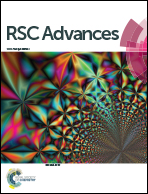p-Nitrophenol degradation and microbial community structure in a biocathode bioelectrochemical system†
Abstract
The biocathode bioelectrochemical system (bioc-BES) was used for p-nitrophenol (PNP) degradation with sodium bicarbonate as the carbon source. The PNP degradation efficiency in bioc-BES with applied voltage of 0.5 V reached 96.1% ± 0.5% within 72 h, which was much higher than that obtained in the biocathode BES without applied voltage (bioc-BES-NAP), open circuit biocathode BES (OC-bioc-BES) or abiotic cathode BES (abioc-BES). With the increase in the PNP concentration from 20 mg L−1 to 60 mg L−1, the PNP concentration of the effluent decreased from 21.66 ± 2.94 mg L−1 to 0.38 ± 0.1 mg L−1 in 48 h. The final reductive product of PNP was p-aminophenol (PAP) in the biocathode chamber. High-throughput 454 pyrosequencing showed that predominant populations in the biocathode biofilm of bioc-BES were affiliated with electrochemically active Delftia and Diaphorobacter, while Aminobacter was the predominant population in the biocathode biofilm of the bioc-BES-NAP and OC-bioc-BES. These results suggested that microbial electrocatalysis and electrochemically active bacteria on the cathodic electrode accelerated PNP degradation in the biocathode BES (bioc-BES). The biocathode BES will be a promising treatment technology for PNP-containing wastewater.


 Please wait while we load your content...
Please wait while we load your content...